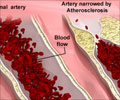- Cigarette smoking is one of the most important factors in the development of cardiovascular disease risk and the identification of a gene variant has uncovered a mechanism of action.
- A gene variation close to the gene for ADAMTS7 is found to lower the level of the enzyme ADAMTS7. High levels of ADAMTS7 increase the development of plaques.
- The gene variant that lowers ADAMTS7 level provides a protective effect against cardiovascular disease, which is largely neutralized by cigarette smoking.
ADAMTS7 Enzyme
The research team identified the molecule ADAMTS7(A disintegrin and metalloproteinase with thrombospondin motifs 7), an enzyme produced in the linings of the blood vessels. Earlier research has shown that an increase in the enzyme ADAMTS7 leads to fatty plaque buildup in the coronary arteries which in turn results in coronary heart disease.Gene Connection
The research team found that certain gene variations resulted in lower production of the enzyme ADAMTS7; this contributed towards lowering the risk of cardiovascular disease. Though there is a natural protective effect afforded by this gene variation, this effect is largely lost in smokers. The study found that smoking, in fact, leads to an increase in ADAMTS7 production, thereby neutralizing most of its protective impact.Gene Analysis
This was one of the largest studies conducted on genetic interaction between smoking and cardiovascular disease risk as the research team used data from 29 earlier studies on about 140,000 people.- 45 loci that were previously found to be associated with an abnormal risk of cardiovascular heart disease were analyzed.
Gene Polymorphism
In a region close to the ADAMTS7 gene, the research team found a single polymorphism which was associated with smoking and cardiovascular disease risk.- 40% of Europeans carried this gene polymorphism
- It was found to be linked with a 12% lower risk of cardiovascular disease risk among non-smokers and a 5% lower risk of cardiovascular disease risk among smokers
Smoking as a Modifier
The research team carried out an associate experiment where a liquid extract of cigarette smoke was applied to cells that line the coronary arteries, in a culture dish. The study results showed that the production of ADAMTS7 doubled, thus diminishing the protective effect of the gene variant.Other Disease Conditions
The level of ADAMTS7 is not only associated with coronary heart disease but also with certain types of cancer as well as arthritis.Smoking and Cardiovascular Disease Risk
Smoking cigarettes is found to increase the risk of cardiovascular disease and the following are the probable mechanisms- The linings of arteries are damaged, leading to fatty plaque build up. This reduces the size of the artery and increases the risk of coronary heart disease.
- Smoking cigarettes increases carbon-monoxide, which lowers oxygen in the blood, necessitating harder pumping of the heart.
- Cigarettes contain nicotine that stimulate the production of adrenaline, which increases the heart rate.
Preventive strategies could target ways by which the enzyme level is lowered among people who smoke. Dr. Saleheen and colleagues are working on identifying other gene variants which could interact with lifestyle factors and affect cardiovascular disease risk. These studies could lead to cost-effective strategies that lower the risk of cardiovascular disease.
References:
- Smoking - (https://www.bhf.org.uk/heart-health/risk-factors/smoking)
- Global adult tobacco survey - (http://www.who.int/tobacco/surveillance/en_tfi_india_gats_fact_sheet.pdf)
Source-Medindia















